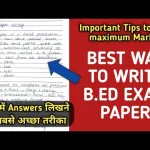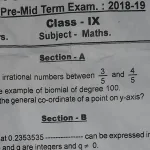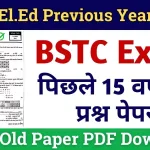SSLC IT theory questions help students understand fundamental concepts of information technology. Covering topics across all subjects, these questions enhance exam readiness and knowledge. Clear and concise answers simplify learning and boost confidence for exams.
Mathematics
Question: What is the formula to calculate the area of a circle?
Answer:
The formula to calculate the area of a circle is πr2\pi r^2, where rr is the radius of the circle.
Question: How do you find the perimeter of a rectangle?
Answer:
The perimeter of a rectangle is calculated using 2×(length+breadth)2 \times (length + breadth).
Question: What is the Pythagorean theorem?
Answer:
The Pythagorean theorem states that in a right triangle, a2+b2=c2a^2 + b^2 = c^2, where cc is the hypotenuse.
Question: Define a prime number.
Answer:
A prime number is a natural number greater than 1 that has no divisors other than 1 and itself.
Question: What is the value of 16\sqrt{16}?
Answer:
The value of 16\sqrt{16} is 4.
Question: Explain the term “linear equation.”
Answer:
A linear equation is an equation in which the highest power of the variable is 1.
Question: What is the slope of a line?
Answer:
The slope of a line measures its steepness and is calculated as rise/run\text{rise}/\text{run}.
Question: How is the mean of a dataset calculated?
Answer:
The mean is calculated by dividing the sum of all data points by the number of data points.
Question: What is a histogram?
Answer:
A histogram is a graphical representation of data using bars of varying heights.
Question: What is the value of 707^0?
Answer:
The value of 707^0 is 1.
Question: Define an acute angle.
Answer:
An acute angle is an angle that measures less than 90 degrees.
Question: How do you convert a fraction into a percentage?
Answer:
To convert a fraction to a percentage, multiply the fraction by 100 and add the percentage symbol.
Question: What is the probability of flipping a coin and getting heads?
Answer:
The probability is 1/21/2.
Question: Explain the term “factorial.”
Answer:
A factorial is the product of all positive integers up to a given number nn, represented as n!n!.
Question: What is the formula for the circumference of a circle?
Answer:
The formula is 2πr2 \pi r, where rr is the radius.
Question: Define a quadratic equation.
Answer:
A quadratic equation is an equation of the form ax2+bx+c=0ax^2 + bx + c = 0.
Question: What is a composite number?
Answer:
A composite number is a number greater than 1 that has more than two divisors.
Question: How is the median of a dataset determined?
Answer:
The median is the middle value in an ordered dataset or the average of the two middle values if the dataset has an even number of elements.
Question: What is a right angle?
Answer:
A right angle is an angle that measures exactly 90 degrees.
Science
Question: What is the smallest unit of matter?
Answer:
The smallest unit of matter is an atom.
Question: Define photosynthesis.
Answer:
Photosynthesis is the process by which green plants use sunlight to synthesize food from carbon dioxide and water.
Question: What is the function of the heart?
Answer:
The heart pumps blood throughout the body, supplying oxygen and nutrients.
Question: What is Newton’s second law of motion?
Answer:
Newton’s second law states that F=maF = ma, where force equals mass times acceleration.
Question: What is the boiling point of water?
Answer:
The boiling point of water is 100°C at standard atmospheric pressure.
Question: What are the three states of matter?
Answer:
The three states of matter are solid, liquid, and gas.
Question: Define an ecosystem.
Answer:
An ecosystem is a community of living organisms interacting with their environment.
Question: What is the chemical formula of water?
Answer:
The chemical formula of water is H2OH_2O.
Question: Explain the term “evaporation.”
Answer:
Evaporation is the process by which a liquid turns into vapor.
Question: What is the main function of red blood cells?
Answer:
Red blood cells transport oxygen from the lungs to the body tissues.
Question: What is gravity?
Answer:
Gravity is the force that attracts objects toward the center of the Earth.
Question: What is the speed of light in a vacuum?
Answer:
The speed of light in a vacuum is 3×1083 \times 10^8 meters per second.
Question: Define a chemical reaction.
Answer:
A chemical reaction is a process where substances transform into new substances.
Question: What is DNA?
Answer:
DNA (Deoxyribonucleic Acid) is the molecule that carries genetic information.
Question: What is the function of the lungs?
Answer:
The lungs exchange oxygen and carbon dioxide during respiration.
Question: Define potential energy.
Answer:
Potential energy is the energy possessed by an object due to its position or configuration.
Question: What is an acid?
Answer:
An acid is a substance that releases hydrogen ions (H+)(H^+) in solution.
Question: What is the function of the nervous system?
Answer:
The nervous system transmits signals between different parts of the body.
Question: What is the pH scale?
Answer:
The pH scale measures the acidity or alkalinity of a solution, ranging from 0 to 14.
Question: Define friction.
Answer:
Friction is the force that opposes the motion of an object.
SSLC IT theory questions provide a solid foundation for understanding core concepts across subjects. With clear explanations and comprehensive coverage, these questions prepare students for exams effectively.
Latest Posts
- Step-by-step guide to download and apply for jee mains admit card 202
- Comprehensive 2025 government holidays and recruitment details for job seekers
- JEE Mains Admit Card 2025: Your Step-by-Step Guide to Downloading the Hall Ticket
- Everything You Need to Know About 2025 Government Holidays Recruitment
- Comprehensive Guide to rrb d group recruitment 2025 – Eligibility, Vacancies, and Application
- Detailed guide to nps trust recruitment 2025 vacancies, eligibility and apply process
- Comprehensive guide to hpcl recruitment 2025 notification, vacancies, and application process
- ignou bed admission 2025 complete recruitment guide with eligibility and process
- Comprehensive Guide to Indian Army Agniveer Recruitment 2025 Notification and Jobs
- Everything You Must Know About CBSE Board Exams 2025 Changes & New Rules





